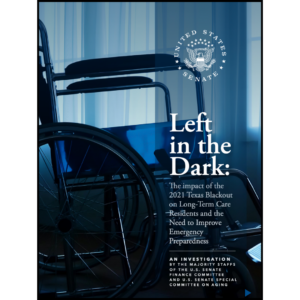Review and update LTC emergency plans with operational changes
Long-term care providers around the nation have experienced the impact of challenging economic times. Many communities including skilled nursing homes, assisted living facilities and independent senior living properties have been forced to downsize elements of operations, resulting in the reassignment of personnel, redistribution of staff responsibilities, elimination of positions, closing of facilities and consolidation of other aspects of facilities management. Some of these changes may have occurred quickly while the operation was under a great deal of pressure to maintain quality of care while dealing with the reality of decreased census and revenue. When changes occur, it is essential to review and update your community’s emergency plans to help ensure that the changes have been incorporated into these essential documents.
 Keeping emergency procedures and disaster preparedness/emergency management plans up to date is an essential element of your facility’s Life Safety compliance program. LTC communities of all types commonly develop and maintain comprehensive plans to address a variety of emergency situations ranging from routine power failures to disaster scenarios requiring complete facility evacuation. In some cases, these response protocols and associated documents are required by regulation while in others, facilities have developed comprehensive written contingencies including plans, policies and procedures designed to help control potential losses and minimize risk exposure.
Keeping emergency procedures and disaster preparedness/emergency management plans up to date is an essential element of your facility’s Life Safety compliance program. LTC communities of all types commonly develop and maintain comprehensive plans to address a variety of emergency situations ranging from routine power failures to disaster scenarios requiring complete facility evacuation. In some cases, these response protocols and associated documents are required by regulation while in others, facilities have developed comprehensive written contingencies including plans, policies and procedures designed to help control potential losses and minimize risk exposure.
It is not uncommon for surveyors to review these types of plans during the course of an assessment and find that information is out of date or not applicable due to significant changes that have occurred within the facility or parent corporation. These changes can include the following:
Operational Changes
- Expansion
- Downsizing
- Consolidation
- Merger
Facility Changes
- Floor plan changes
- New construction
- Demolition
- Remodeling
- Temporary structures
- Elimination of beds/facilities
Personnel Changes
- New employees
- Promotion
- Demotion
- Elimination of position
- New assignment/position
- Re-assignment to a new location within a campus or organization
- Retirement
- Departure from company/organization
Personnel Contact Information Changes
- Phone numbers (home phone and cell)
- Pager number
- E-mail address
- Home address
Community Resources Personnel Changes-Primary Contacts
- Fire Department
- Police/Law Enforcement
- Emergency Medical Services
- County Emergency Management Agency
- Utility Companies-electric, gas, water, cable system, etc.
- Contractors-construction, electrical, plumbing, board-up service, etc.
Community Resources Contact Information Changes
- Phone numbers (business phone and cell)
- Pager number
- E-mail address
- Business Address
The usefulness of a written plan, policy or procedure is premised on the relevancy and applicability of its information. While a great deal of information contained in these documents does not typically change, dynamic information can be subject to change on a frequent basis. To help ensure that your facility’s written emergency contingencies are kept up-to-date, it is recommended that these documents be reviewed and date-stamped in accordance with the following guidelines:
- At minimum on an annual basis
- Following operational changes
- Following facility changes
- Following personnel changes
- Following community resources changes
- Any time it appears practical to review and update
Significant changes in the operation of LTC communities as well as sectors of local emergency services (fire department, law enforcement, police, etc.) due to economic factors is likely a trend we will continue to see for quite some time. It is essential to review and update all elements of your emergency contingencies including written documents as well as your overall risk management program to help ensure the accuracy and reliability of all information after these changes have occurred.

Stan Szpytek is the president of consulting firm Fire and Life Safety, Inc., in Mesa, Arizona, and is the Life Safety/Disaster Planning Consultant for the Arizona Health Care Association and California Association of Health Facilities. Szpytek is a former deputy fire chief and fire marshal with more than 35 years of experience in life safety compliance and emergency preparedness. For more information, visit www.emallianceusa.com or email Szpytek at Firemarshal10@aol.com.
Related Articles
Topics: Disaster Preparedness , Executive Leadership , Facility management , Operations











